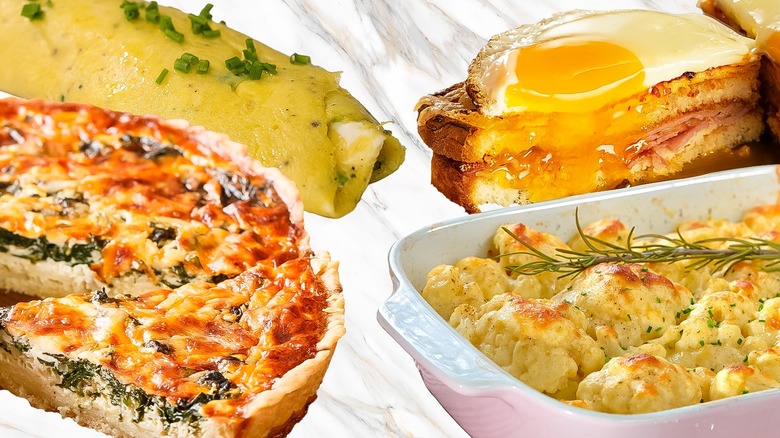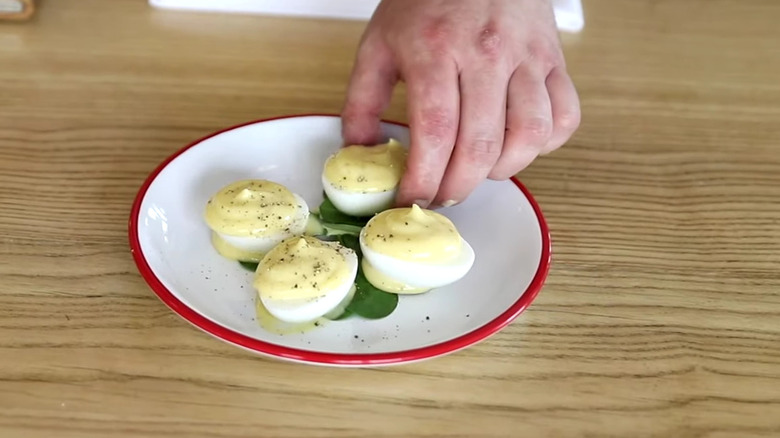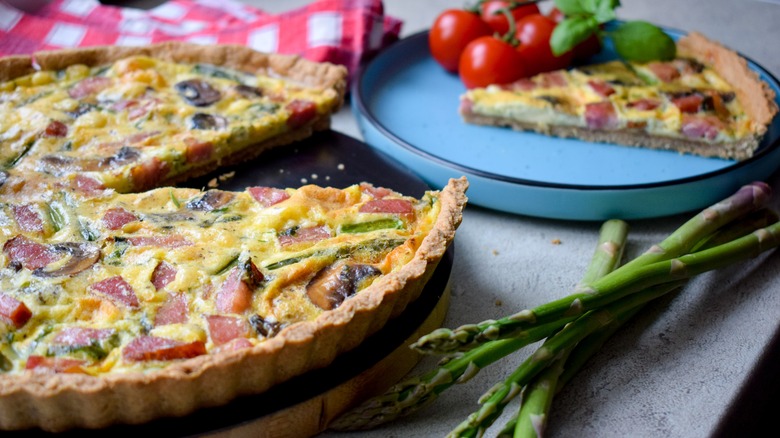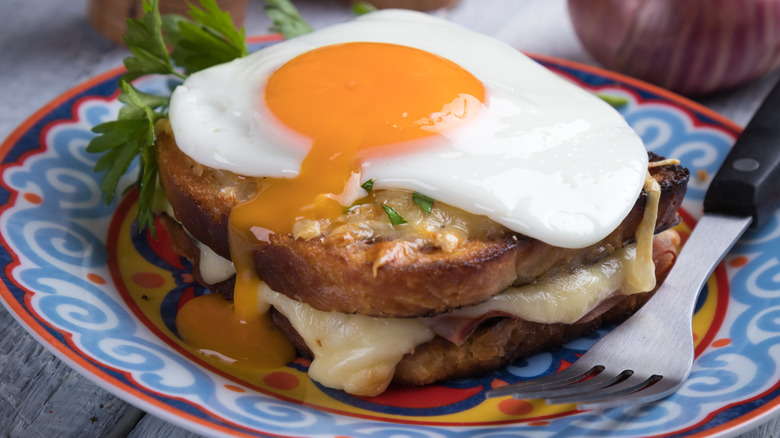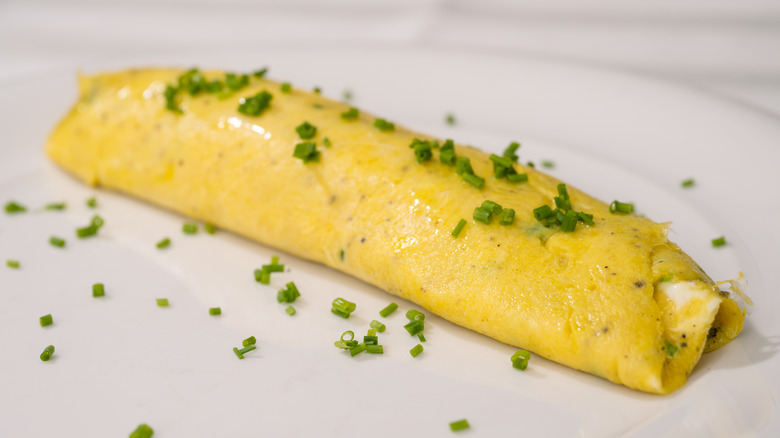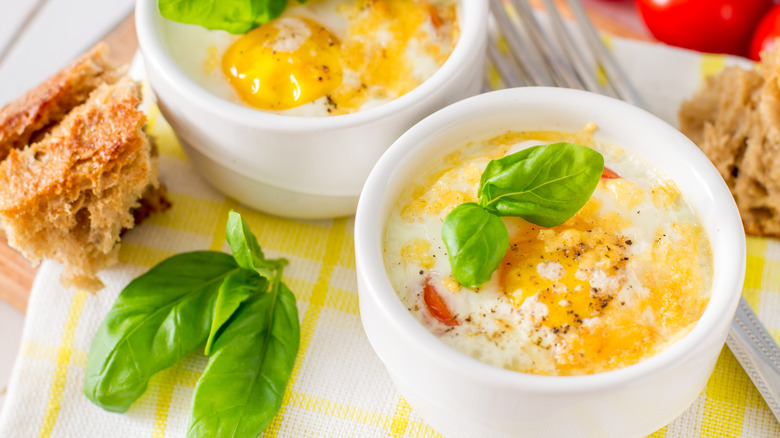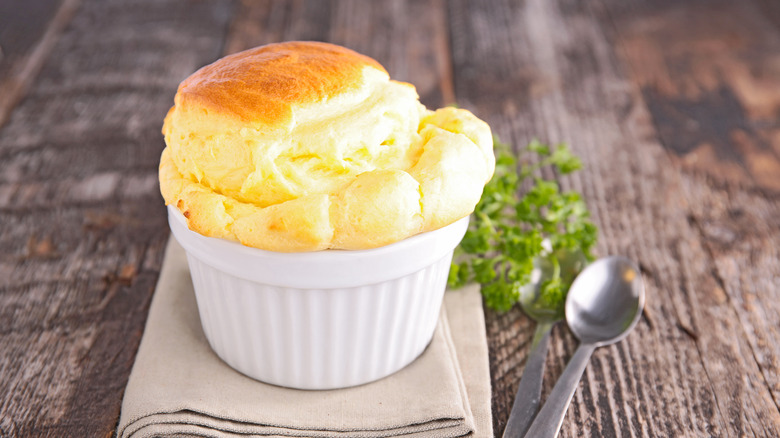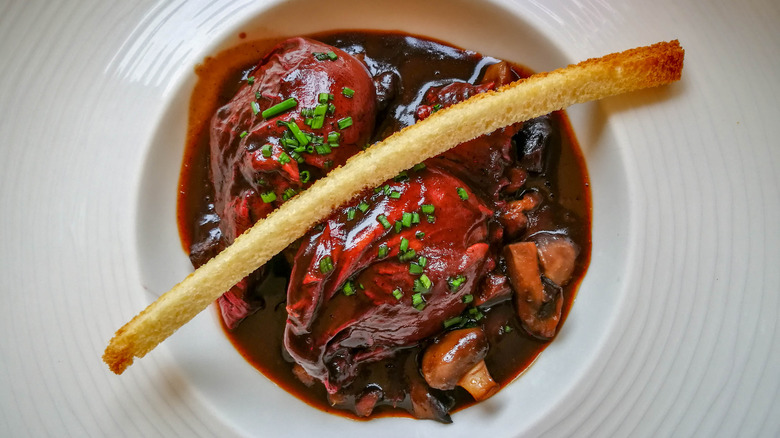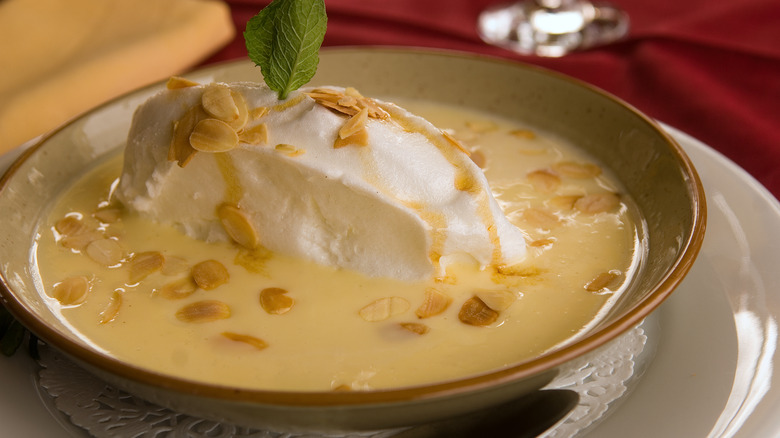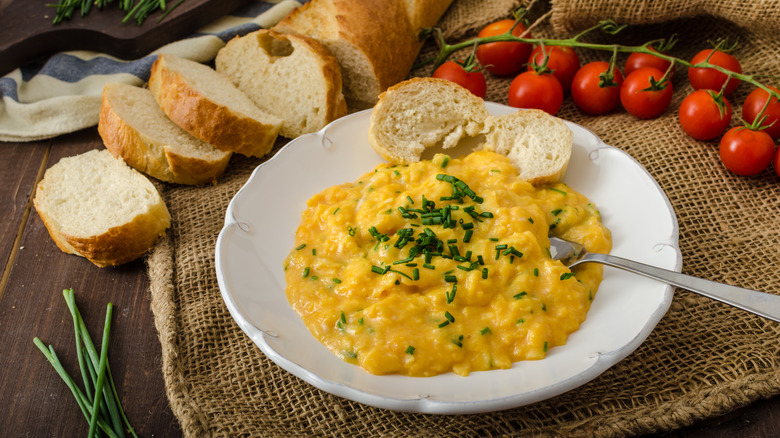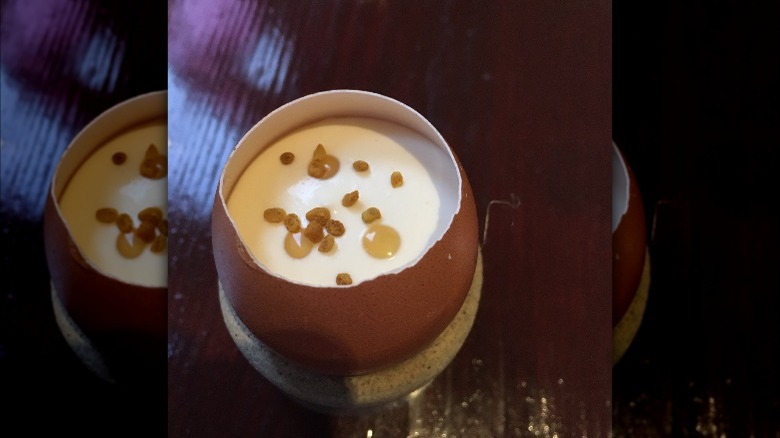10 French Egg Dishes You Need To Know About
French cuisine has long dominated cookbook aisles, culinary school curriculums, and Michelin star awards. The cuisine has been so prevalent for so long that many home cooks believe they have an in-depth understanding of French cooking. While this may be true for some, it most definitely is not for all. French cuisine is extremely multifaceted. Mastering it requires more than simply knowing how to cook Jacques Pépin's coq au vin or Julia Child's beef bourguignon.
Take the egg, for example. This humble ingredient is often overlooked by those who erupt into excited chatter every time saucisson, Brie, or Bordeaux are mentioned. We have been taught that charcuterie, cheeses, and wines are much more exciting and French. Yet, eggs demonstrate the range and versatility of French cuisine better than any of the aforementioned ingredients. They are the star in bistro classics, just as they are an integral part of fine dining desserts. Perhaps most importantly, eggs are vital to many regional dishes that, while not included in most cookbooks or curriculums, are the lifeblood of the world's most hallowed cuisine.
1. Oeuf mayonnaise
Oeuf mayonnaise — or egg mayo, if you will — sounds more like a gas station sandwich than an esteemed French appetizer. In classic French style, however, this bistro classic manages to be both simpler and far more elegant than the English translation would suggest.
The dish is made by boiling an egg till it attains a hard but jammy yolk. Once cooked, the egg is halved and placed onto a plate before being topped with mayonnaise. Chopped chives, or other garnishes, can be added to finish. Such a simple dish demands attention to detail: the mayonnaise should be homemade, well-seasoned, and light enough to flow over the eggs. The egg itself must be perfectly cooked. A rubbery white could ruin the dish.
Oeuf mayonnaise's beautiful simplicity, which demands exacting skill, makes it a valued part of French cuisine. This is despite the fact that it remains relatively unknown outside of the country. The French populace's opinion of oeuf mayonnaise is so high that an association was created to protect the dish, the Association de sauvegarde de l'oeuf mayonnaise. Aside from safeguarding, the association runs an annual competition to find the best oeuf mayo. Throughout the year, it also sells oeuf mayo merchandise and gives awards to bistros that serve exceptional versions of the dish.
2. Quiche
Quiche is a robust dish that has outlasted cycles of popularity and disfavor. It has subsequently become a well-loved part of many a home cook's repertoire. Key to quiche's staying power is its versatility; numerous variations of the dish can be made by adding ingredients to the savory custard and cheese filling. One of the most prominent of these variations is quiche Lorraine, which is made with bacon lardons. This dish has origins in medieval Germany. Other quiche variations are unmistakably French, such as quiche Provençale. This quiche often uses zucchini, tomatoes, and a mixture of herbs – which are all found in France's Provence region.
Most recently, quiche has been given a British makeover to celebrate the coronation of King Charles III. This "coronation quiche" contains spinach, broad beans, and tarragon — a marriage of ingredients from both Britain and France. Unfortunately, it was not so popular with the French. Many French newspapers labeled the dish a tart rather than a quiche, suggesting there are limits to even quiche's famed versatility.
3. Croque madame
The croque madame is a variation of an excellent French classic, the croque monsieur, which has been served in France for over 100 years. A croque monsieur is a grilled ham, Gruyère, and Dijon mustard filled sandwich. After grilling, the sandwich is smothered with bechamel sauce, topped with more melted cheese, and broiled to finish. Transforming a croque monsieur into a croque madame is simple. All you have to do is top the croque monsieur with a fried egg.
While promising on paper, croque madames can be disappointing if not executed properly. Greasy, soggy versions of this iconic sandwich abound. When done well, however, the rich egg yolk marries perfectly with crisp bread and gooey cheese, resulting in an unrivaled, indulgent meal.
Fortunately, the croque madame is one French egg dish that has become well-established in the United States. Great versions of it can be found in many American restaurants including New York's iconic French eatery, Balthazar.
4. French omelet
It's rare to find a topic that numerous chefs agree on — divided as they are in matters of taste, technique, and presentation. The importance of the French omelet, however, is one thing most chefs wholeheartedly respect. The dish is considered the perfect measure of a cook's skill, as celebrity chef Wolfgang Puck told Bon Appétit: "When we hire any chef for our restaurants, I tell them to make me an omelet, because an omelet is one of the basics every chef should know. Yet very few can make a perfect omelet so that it's perfectly cooked and perfectly shaped." Fellow food media star and chef Anthony Bourdain even went so far as to suggest how an individual makes an omelet reveals something about their character.
Like many recipes on this list, making a French omelet is all about technique and restraint. In stark comparison to the gargantuan, stuffed omelets that are served in diners across the U.S., French omelets are frequently made with eggs alone, rolled up, and served while still moist in the middle. In terms of technique, the eggs should be mixed until combined, then added to a buttered pan. You then move the eggs around the pan in a figure-eight motion until they are slightly cooked. This results in a homogenous omelet that can be delicately rolled before being rubbed with butter.
5. Oeufs cocotte
While the French omelet requires cooks to demonstrate their technical ability, oeufs cocotte needs almost no skill to make well. Instead, an ingenious cooking method does the brunt of the work. You simply place an egg into a ramekin. This is then placed into a water bath, and then the whole thing goes into a 350-degree Fahrenheit oven. The water bath results in a gentler transfer of heat from the oven to egg, making a well-cooked egg with a runny yolk.
The water bath is what distinguishes oeufs cocotte from a similar dish known as shirred eggs. This variation, which is baked straight in the oven, has long been popular in the U.S. However, shirred eggs is somewhat denser than oeufs cocotte, and lacks the looseness that makes the French dish so appealing to dip into. As the cooking means are almost identical, we would suggest giving the French oeufs cocotte a try. Who knows, the dish might become your next favorite breakfast.
6. Soufflé
Soufflés are a notoriously difficult dish to master. Perhaps because of their challenging nature, both sweet and savory versions of the dish have become less prominent than they once were. People say soufflés are unnecessarily complicated, too delicate, and old-fashioned. But we think there is value in learning how to cook this classic dish.
Both sweet and savory soufflés are made by separating egg white and yolks, then whipping the former to stiff peaks. The latter are beaten with other ingredients, adding flavor to the dish. For savory soufflés, cheese is preferred. Sweet ones require sugar. Both undergo an excruciating bake during which they will either triumphantly rise or collapse in a heap.
Although making them is a tension-laced labor of love, eating a perfect soufflé is one of the great gastronomic privileges. This contrast makes soufflés one of French cuisine's most maddening obsessions, a sentiment chef Patrick O'Connell perfectly summarized to Eater: "Soufflés are hard to beat, hard to perfect, and hard to maintain consistency. But why should something so wonderful ever go out of style?"
7. Oeufs en meurette
Bordeaux, Champagne, Burgundy: France's wine-producing regions need no introduction. Drinking will always be the best way to enjoy the bottles from these hallowed vineyards, although cooking with them comes a close second thanks to iconic, wine-laden dishes such as beef bourguignon. It is not only meat that benefits from a glug of wine but eggs too.
Oeufs en meurette is a dish of eggs poached in Burgundy pinot noir. It's a classic example of how eggs and wine can complement each other. The eggs and poaching liquid — which is made from a mixture of reduced stock and wine — are served on top of toast, alongside a mixture of fried vegetables like mushrooms and onions, as well as lardons. Other, more affordable wines can be used in place of a prime bottle of Burgundy. Some cooks also prefer to poach the eggs separately, ensuring they do not adopt the sauce's reddish hue.
Although relatively unknown in the U.S., oeufs en meurette is a big deal in France — so much so that an annual oeufs en meurette world championship has been held in the country since 2019.
8. Île flottante
Île flottante is a famous French dessert known in English as floating islands. As the name suggests, the dish features poached or baked meringues that "float" atop a pool of creme anglaise. The dish is divisive as chef and cookbook author David Lebovitz highlighted to Eater: "One of my all time favorite desserts is floating island, and people either love it or hate it. It's a bowl of really cold creme anglaise with poached meringue and caramel sauce. Ideally it should it be sweet but — I don't really like things that are really sweet it should be sweet but not too sweet."
Popular in the U.S. during the latter part of the 20th century, île flottante suffered the fate of many dishes from this time. It became outdated. Yet, the dish's unique aesthetic and simple flavors have ensured it remains a feature on menus in prominent Parisian eateries like Restaurant Georgette. Perhaps an American renaissance of the dish is well overdue.
9. Oeufs brouillés
Oeufs brouillés is the French term for scrambled eggs. While familiar, there are many things that differentiate French scrambled eggs from their American counterparts. The most noticeable of these is texture: French scrambled eggs are much looser than those popular in America. A cooking method defined by low temperatures and long durations is how this is achieved.
The cooking process for French scrambled eggs can take place in a pan or bain-marie. Both, however, require the eggs to be constantly whisked in order to prevent the formation of large curds — the enemy of this dish's creamy texture.
Much like the French omelet, scrambled eggs are a great way of measuring a cook's capabilities. Gordon Ramsay expressed this view to The Daily Mirror: "Every time we get a new cook in the kitchen we always ask them to make scrambled eggs. And if they can make the perfect scrambled egg, you know they know how to cook properly." While what constitutes "proper" scrambled eggs remains a topic of debate, it is undeniable that the French method results in a unique dish with an unrivaled, luxurious texture.
10. L'Arpège egg
Despite being affordable and plentiful, eggs have managed to develop an association with both fine dining and prestige within French cuisine. This association dates back to at least the 18th century when crowds gathered to watch King Louis XV eat his breakfast of boiled eggs. Today, the relationship between eggs and French fine dining remains, albeit in a less regal manner, thanks to chef Alain Passard.
Instead of boiled eggs, Passard serves a dish known as l'Arpège Egg at his three-Michelin-starred restaurant Arpège. L'Arpège Egg is made by cooking egg yolks in a water bath, placing them in an eggshell, and topping them with crème fraîche whipped with sherry vinegar, maple syrup, and salt. The dish is notoriously difficult to make. As such, many will only experience it in Arpège's famed dining room, making l'Arpège Egg inaccessible to most diners.
